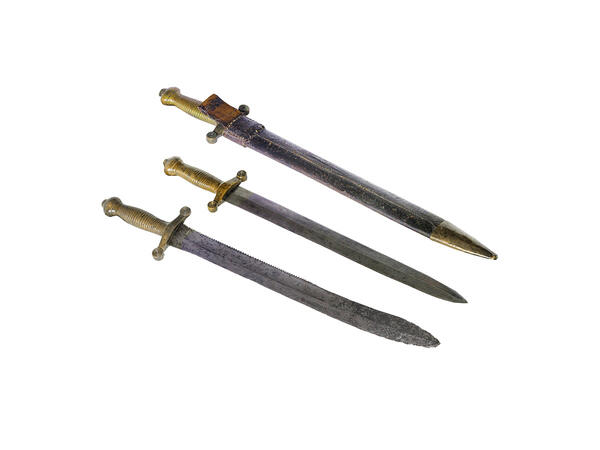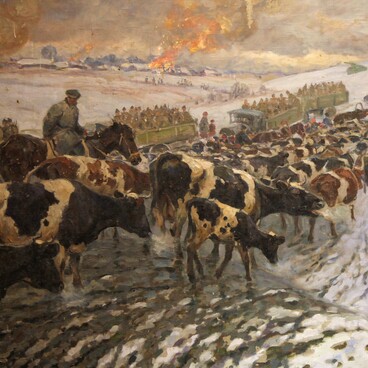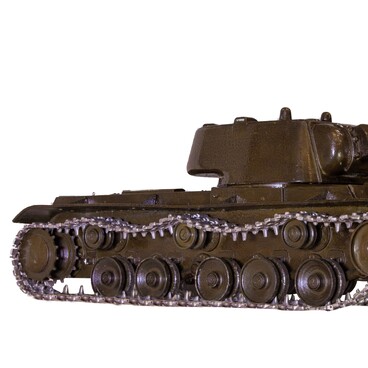The urgent need to rearm the infantry troops arose as early as the last third of the 17th century. Specifically, it was a need for the type of edged weapons, which the soldiers could use in everyday life for everyday needs: to cut wood or a tree. That is why the fascine knives were adopted by the Russian soldiers.
Russian fascine knives of that time typically had a hilt (handle), which was forged from brass. The scabbard was made out of wood and covered in leather. The tip and the upper part of the scabbard (the mouth) were metal.
From the mid-18th century till the second half of the 19th century, the Russian army soldiers carried three basic types of fascine knives: for the infantry, the marines, and sappers. The museum exposition displays one sapper and two infantry fascine knives, which were dated to the 19th century.
The sapper fascine knife models of 1834 had a straight steel blade, sharpened at one end — the single-edge blade. Only the striking end of the weapon had a double-edge blade. Two-thirds of the length had indents, which were similar to the teeth on a saw. The brass handle of the fascine knife had many lateral notches on it, so that it would not slip and was easier to hold.
Such a design was necessary because the sappers of that time mainly performed a variety of military engineering duties. They dug trenches and built bridges and field fortifications for infantry and artillery batteries. Their duties also included the preparation of fascines — thick bundles of brushwood, which they used to fill up the enemy trenches during an attack. However, if necessary, fascine knifes could also be used for self-defense.
In 1848, a new infantry fascine knife was made to equip the soldiers of the lower ranks of the Caucasus Corps infantry. And, in 1855 it was also used by the infantry and sappers. The earlier version was no longer in use.
The blade of the infantry fascine knife was shorter than its predecessor’s — 45 centimeters. It was just as straight but sharpened all the way around on both sides.
In 1868, all troops were required to carry the artillery soldier’s sword (a shashka). Therefore, by 1880, the infantry fascine knife was eliminated. In peacetime, it was worn only by the Guard Infantry and the Life Guard Regiment of the Sapper Brigade in those cases when the soldier did not carry his rifle. The 1848 variant remained in use only by musicians and drummers of other troops. However, until the outbreak of World War I, the fascine knife remained a part of the official uniform.
Russian fascine knives of that time typically had a hilt (handle), which was forged from brass. The scabbard was made out of wood and covered in leather. The tip and the upper part of the scabbard (the mouth) were metal.
From the mid-18th century till the second half of the 19th century, the Russian army soldiers carried three basic types of fascine knives: for the infantry, the marines, and sappers. The museum exposition displays one sapper and two infantry fascine knives, which were dated to the 19th century.
The sapper fascine knife models of 1834 had a straight steel blade, sharpened at one end — the single-edge blade. Only the striking end of the weapon had a double-edge blade. Two-thirds of the length had indents, which were similar to the teeth on a saw. The brass handle of the fascine knife had many lateral notches on it, so that it would not slip and was easier to hold.
Such a design was necessary because the sappers of that time mainly performed a variety of military engineering duties. They dug trenches and built bridges and field fortifications for infantry and artillery batteries. Their duties also included the preparation of fascines — thick bundles of brushwood, which they used to fill up the enemy trenches during an attack. However, if necessary, fascine knifes could also be used for self-defense.
In 1848, a new infantry fascine knife was made to equip the soldiers of the lower ranks of the Caucasus Corps infantry. And, in 1855 it was also used by the infantry and sappers. The earlier version was no longer in use.
The blade of the infantry fascine knife was shorter than its predecessor’s — 45 centimeters. It was just as straight but sharpened all the way around on both sides.
In 1868, all troops were required to carry the artillery soldier’s sword (a shashka). Therefore, by 1880, the infantry fascine knife was eliminated. In peacetime, it was worn only by the Guard Infantry and the Life Guard Regiment of the Sapper Brigade in those cases when the soldier did not carry his rifle. The 1848 variant remained in use only by musicians and drummers of other troops. However, until the outbreak of World War I, the fascine knife remained a part of the official uniform.



